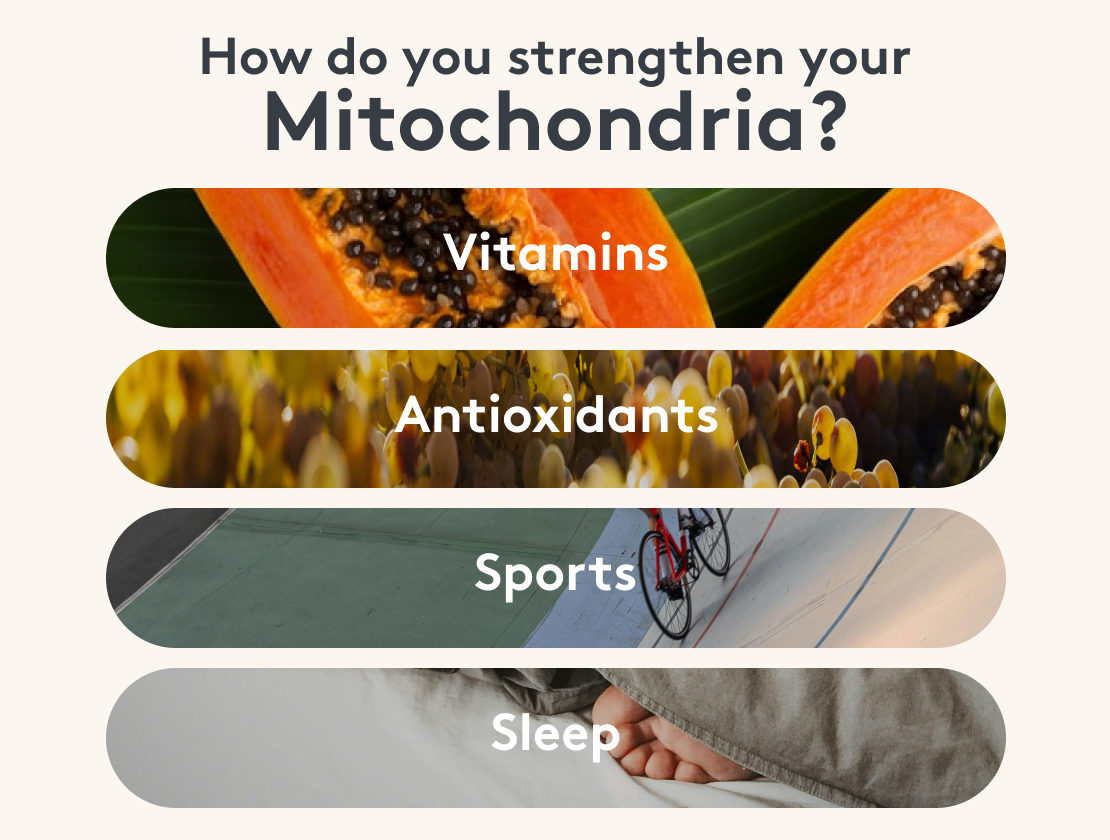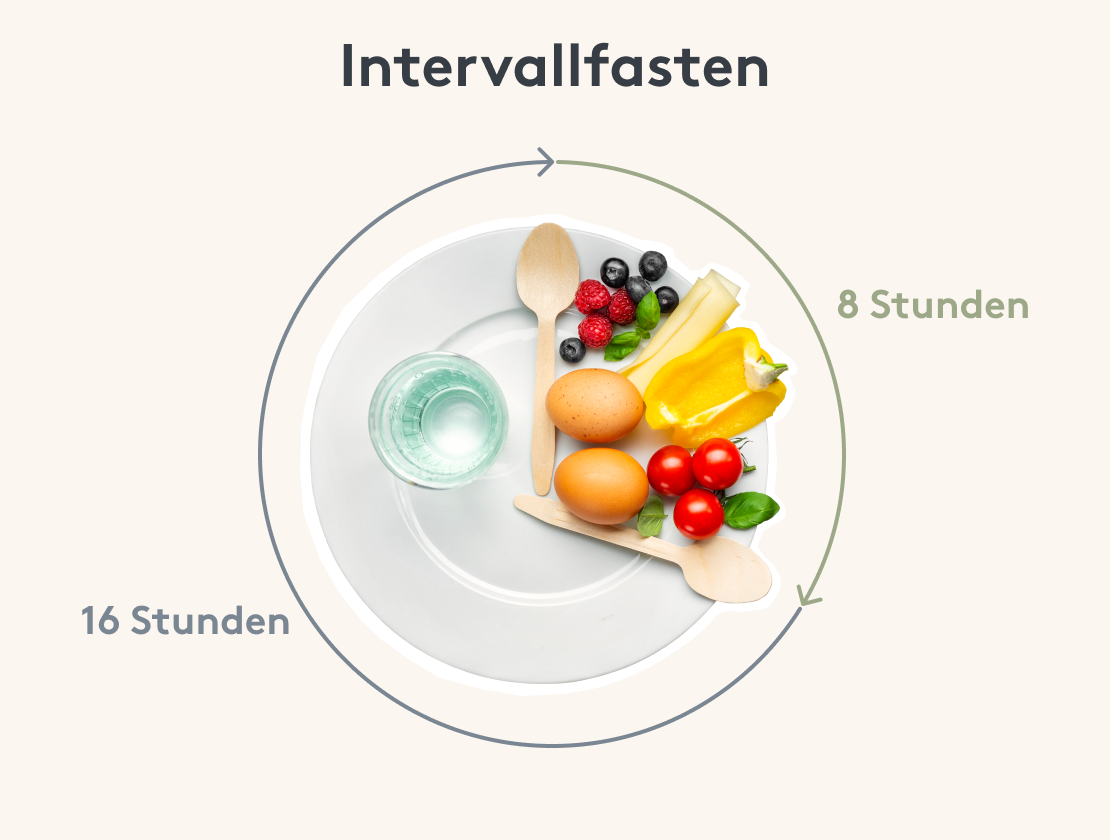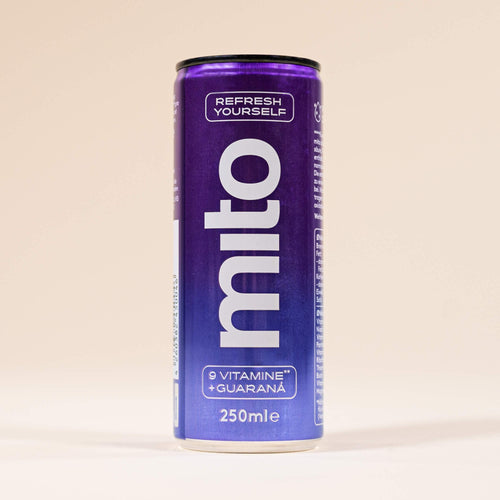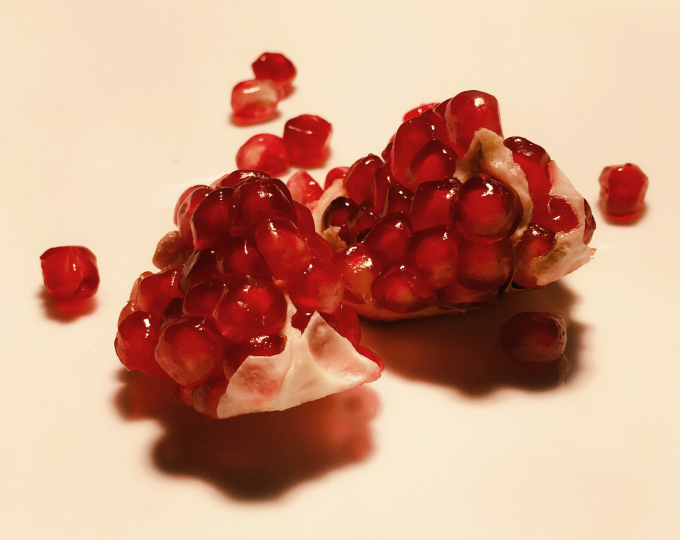Themen dieses Blogartikels:
Table of contents
- What is a mitochondrion?
- Why strengthen your mitochondria?
- 8 tips to strengthen your mitochondria
- Tip no. 1: Incorporate intermittent fasting into your everyday life
- Tip no. 2: Try IHHT and altitude training
- Tip no. 3: Switch to a low sugar diet
- Tip no. 4: Strengthen mitochondria with micronutrients
- Tip no. 5: Catch radicals
- Tip no. 6: Get more exercise
- Tip no. 7: Good sleep
- Tip no. 8: Low-pollutant and nutritious diet
- Strengthen the cells' power plants and go through life with energy
- Bibliography
What is a mitochondrion?
Mitochondria are important components of your body's cells. They are found in almost every cell, with the exact number depending on how much energy is needed in the respective cell. Mitochondria are called the power plants of our cells because their main task is to ensure that your body is supplied with energy and to give you power for everyday life.
To do this, the mitochondria produce your body's most important energy carrier, adenosine triphosphate (ATP). An energy-rich molecule, such as glucose or fatty acids and oxygen, is required for production.
Want to find out more about the structure and function of your mitochondria? Then read our basic article on mitochondria first.
Why strengthen your mitochondria?
Everyone has a little slump from time to time. However, if you feel tired for no apparent reason, your mitochondria could be the cause. Just like you, mitochondria are affected by the environment. They may be affected by oxidative stress or their performance may be impaired by mutations.
The better your mitochondria function, the higher your energy reserves. It is therefore important to take care of this smallest component of your cells.
You can find out which factors can weaken your mitochondria and how to recognize mitochondrial diseases in our blog.
Advertisement
- 40 bioactive premium active ingredients – everything your mitochondria need as fuel.
- Supports cellular energy, energy levels, performance and efficiency.
- Unique complex developed by our team of doctors and experts.
- Contains vitamins, minerals, amino acids, medicinal mushrooms & many other premium active ingredients.
- No additives or fillers.

8 tips to strengthen your mitochondria
If your mitochondria are doing well, you are doing well too. If ATP production is running at full speed, your performance improves and you feel full of energy. There are many ways to support your cellular power plants in their important work and increase ATP. We now present the eight best measures for strong mitochondria in every single cell.


Tip no. 1: Incorporate intermittent fasting into your everyday life
Typical 16:8 interval fasting is about limiting the time in which you eat. The rest of the time, the body has fewer calories available than it consumes. This activates the so-called post-absorptive metabolism. This metabolism is also known as the starvation metabolism, as it ensures that your cells receive energy even though you are not eating.
The whole thing has a practical side effect: if there are no carbohydrates during the fasting phase, the body compensates for the lack by using your sugar and fat reserves as an energy source and breaking them down more. This boosts fat burning. In addition, blood sugar and insulin levels are better regulated and insulin resistance is prevented1.

Tip no. 2: Try IHHT & altitude training
Many competitive athletes swear by altitude training. The basic idea behind it: In high mountains, the oxygen concentration in the air is reduced so that the body absorbs less oxygen with every breath.
Why is this good? If you train for a long time in the mountains before a competition, the lower oxygen uptake sends signals in the body and ultimately produces more red blood cells so that enough oxygen is bound to the red blood cells in the blood despite the lower oxygen concentration. Back at normal altitudes, the athlete can bind more oxygen because he has more blood cells.
Interval hypoxia-hyperoxia therapy (IHHT), a type of mitochondrial therapy that uses experience from altitude training for therapy while lying down, is derived from this training, which is intended for athletes.
During IHHT, the user breathes air with different oxygen levels through a tube. This first simulates a reduced oxygen supply (hypoxia) and then, to compensate, hyperoxia, i.e. an increased oxygen supply. Studies have shown that only healthy mitochondria can withstand this method and that they are increasingly activated2,3,4,5. Sick, old mitochondria, on the other hand, die off.

Tip no. 3: Switch to a low sugar diet
High sugar consumption has long been associated with diseases such as type 2 diabetes, arteriosclerosis and fatty liver. In these diseases, it is often the case that the mitochondria of those affected only function to a limited extent.
A high amount of sugar can promote insulin resistance and reduce the mitochondrial metabolism. This leads to the sugar fermenting outside the mitochondria. If you want to reduce your sugar intake in everyday life, you should look into sugar alternatives.
Bonus tip: Functional sugars such as D-galactose and D-tagatose can help to ensure the energy supply of your cells' power plants without negatively affecting insulin levels.
Tip no. 4: Strengthen mitochondria with micronutrients
Sugar, fatty acids, amino acids and oxygen are not the only things needed to produce the energy carrier ATP in the power plants of your cells. Many vitamins are also cofactors of mitochondrial enzymes and promote energy production in the cells. These include above all
B vitamins such as vitamin B1
- Vitamin B2
- Vitamin B3
- Vitamin B5
- Vitamin B6
Without nutrients, the corresponding enzymes cannot function properly and the metabolism comes to a standstill. As the body cannot produce vitamins itself, you have to supplement them with food.
In addition to B vitamins, coenzymes such as Q10 or PQQ or trace elements such as iron, selenium and zinc are important for your mitochondria and the function of your energy metabolism.
If you are interested in the effects of various micronutrients and want to improve other areas and processes in your body in addition to your mitochondria, take a look at our micronutrients dictionary. There you can find out which substances will take your mental and physical performance to a new level.
Tip no. 5: Catch radicals
Antioxidants help protect you from oxidative stress and are important for your energy metabolism. These are molecules that neutralize free radicals, especially in your mitochondria. This is why they are called radical scavengers. The best-known free radical scavengers that can strengthen your mitochondria include vitamin C and the fat-soluble vitamin E. Many plant substances can also have a potential antioxidant effect. This has been shown in a large number of studies, in which the well-known polyphenols curcumin6 and OPC7,8 were examined.
Tip no. 6: Get more exercise
Sure, an active lifestyle is good for your body. But did you know that it also benefits the energy power plants in your cells? Strenuous sport or simple activity in the form of a walk stimulate your metabolism and help your mitochondria to produce more energy.
Incidentally, your muscles contain a particularly large number of mitochondria. The reason: a muscle needs to have a lot of energy available very quickly. Sport is therefore not only a basis for strong muscles and endurance, but also effective mitochondrial training - completely natural and simple.
Looking for inspiration for effective training? In our sports blog you will find various tips and information for more exercise in everyday life.
Tip no. 7: Good sleep
Sleep won't solve all your problems, but it will boost your mitochondrial power. While you sleep, your body makes metabolic adjustments, among other things. Scientists have found that lack of sleep increases oxidative stress, while enzymes to neutralize radicals were less active9. It was even shown that the structure of the mitochondria had changed6.
Want to sleep better? Our sleep blog has helpful articles to help you fall asleep and promote restful sleep.
Bonus tip: Are you often stressed in everyday life? Stress can promote mitochondrial dysfunction and burnout. To make your sleep even more effective, combine it with a ritual of rest. For example, take ten minutes for yourself every day before going to sleep. Close your eyes and breathe consciously or incorporate stretching exercises or a short meditation into your routine.
Tip no. 8: Low-pollutant and nutritious diet
In addition to exercise and sleep, a conscious diet plays an important role in your well-being. With regard to your mitochondria, it is particularly important that you eat a diet that is as low in harmful substances as possible.
Among other things, it is helpful to eat more certified organic fruit and vegetables. Conventional foods are often sprayed and may contain residues of pesticides and herbicides. Such substances may have an effect on human mitochondria. At least that is what studies suggest10,11
Secondary plant substances are also beneficial for mitochondrial performance. These are certain chemical compounds found in plants that you supply to your body through a varied diet with different types of fruit and vegetables.
If you include organic vegetables in your diet and cook for yourself from time to time, you will know exactly what is in your food. We regularly provide you with more tips for a balanced diet in our blog.

Strengthen the cells' power plants and go through life with energy
You now know the importance of exercise, sleep and a balanced diet for your mitochondria. These measures are the best basis for strengthening your mitochondria. Our article has not only given you good reasons to do so, but also recommendations for everyday life.
Finally, we have a bonus tip for you: We have dedicated a separate category in our store to mitochondria and phytochemicals. Click through our products and find the right micronutrient support from MITOcare for you.
This article is based on carefully researched sources:
Bibliography
- Cho, Y., Hong, N., Kim, KW, Cho, SJ, Lee, M., Lee, YH, Lee, YH, Kang, ES, Cha, BS, & Lee, BW (2019). The Effectiveness of Intermittent Fasting to Reduce Body Mass Index and Glucose Metabolism: A Systematic Review and Meta-Analysis. Journal of clinical medicine, 8(10), 1645
- Behrendt, T., Bielitzki, R., Behrens, M., Herold, F., & Schega, L. (2022). Effects of Intermittent Hypoxia-Hyperoxia on Performance- and Health-Related Outcomes in Humans: A Systematic Review. Sports medicine - open, 8(1), 70
- Kurhaluk, N., Tkachenko, H., & Nosar, V. (2013). The effects of intermittent hypoxia training on mitochondrial oxygen consumption in rats exposed to skeletal unloading. Annals of clinical and laboratory science, 43(1), 54–63
- Havenauskas BL, Man'kovs'ka IM, Nosar VI, Nazarenko AI, Bratus' LV (2004). Effect of intermittent hypoxic training on indices of adaptation to hypoxia in rats during physical exertion. Fiziolohichnyi Zhurnal, 50 (6), 32-42. PMID: 15732757
- Serebrovskaya, TV, Nosar, VI, Bratus, LV, Gavenauskas, BL, & Mankovska, IM (2013). Tissue oxygenation and mitochondrial respiration under different modes of intermittent hypoxia. High altitude medicine & biology, 14(3), 280–288
- He, Y., Yue, Y., Zheng, X., Zhang, K., Chen, S., & Du, Z. (2015). Curcumin, inflammation, and chronic diseases: how are they linked?. Molecules (Basel, Switzerland), 20(5), 9183–9213
- Shi, X., Shang, F., Zhang, Y., Wang, R., Jia, Y., & Li, K. (2020). Persimmon oligomeric proanthocyanidins alleviate ultraviolet B-induced skin damage by regulating oxidative stress and inflammatory responses. Free radical research, 54(10), 765–776
- Ma, X., Wang, R., Yu, S., Lu, G., Yu, Y., & Jiang, C. (2020). Anti-Inflammatory Activity of Oligomeric Proanthocyanidins Via Inhibition of NF-κB and MAPK in LPS-Stimulated MAC-T Cells. Journal of microbiology and biotechnology, 30(10), 1458-1466
- Melhuish Beaupre, LM, Brown, GM, Braganza, NA, Kennedy, JL, & Gonçalves, VF (2022). Mitochondria's role in sleep: Novel insights from sleep deprivation and restriction studies. The world journal of biological psychiatry : the official journal of the World Federation of Societies of Biological Psychiatry, 23(1), 1–13
- Ferramosca, A., Lorenzetti, S., Di Giacomo, M., Murrieri, F., Coppola, L., & Zara, V. (2021). Herbicides glyphosate and glufosinate ammonium negatively affect human sperm mitochondria respiration efficiency. Reproductive toxicology (Elmsford, NY), 99, 48–55
- Strilbyska, OM, Tsiumpala, SA, Kozachyshyn, II, Strutynska, T., Burdyliuk, N., Lushchak, VI, & Lushchak, O. (2022). The effects of low-toxic herbicide Roundup and glyphosate on mitochondria. EXCLI journal, 21, 183–196

















